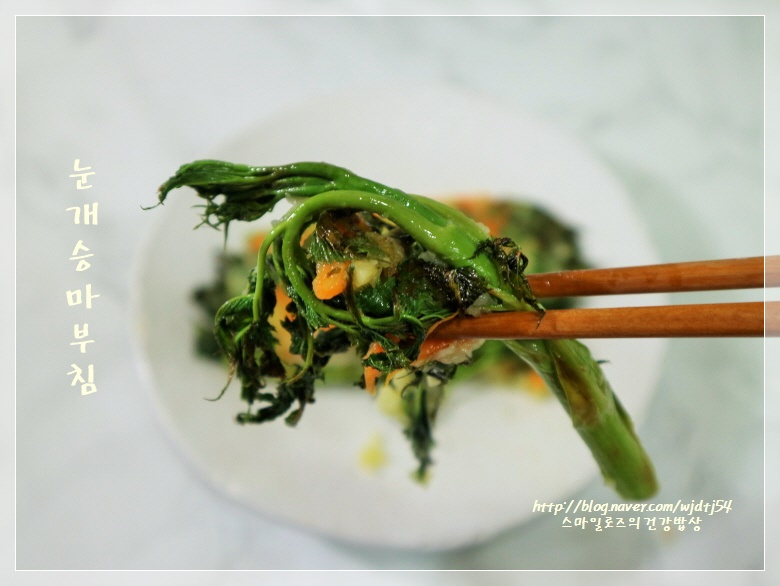Fragrant Aster Scaber Salad (Nunggaengma-muchim)
Spring’s Delicate Delicacy: The Charm of Aster Scaber and How to Enjoy It Deliciously

Among the precious spring vegetables that appear each year, I especially love Aster Scaber (Nunggaengma) for its fragrant aroma and delightfully chewy texture. I am always grateful to the owner of Abeom Farm, who sends me fresh seasonal vegetables every spring. We had such a delicious meal with guests recently using the Aster Scaber I received! We made pan-fried cakes (buchim), a fresh salad (muchim), and even a blanched dish (sookhoe), enjoying the Aster Scaber in various ways. Everyone raved about how incredibly tasty it was.
Main Ingredients- 300g Aster Scaber (Nunggaengma)
Seasoning & Additional Ingredients- 1/2 cup Buchim powder (approx. 50g)
- 1 Tbsp Tuna Extract (approx. 10ml)
- Cooking oil, as needed
- A little julienned carrot
- 1/2 cup Buchim powder (approx. 50g)
- 1 Tbsp Tuna Extract (approx. 10ml)
- Cooking oil, as needed
- A little julienned carrot
Cooking Instructions
Step 1
Aster Scaber is most delicious when harvested young and tender, before it flowers and grows too large. At this stage, a light blanching makes it perfect for a fresh salad, offering a crisp texture akin to eating it raw.

Step 2
Rinse the Aster Scaber thoroughly under running water. To remove any potential residual pesticides and ensure freshness, fill a bowl with plenty of water, add half a cup of baking soda and half a cup of vinegar, and let it soak for about 10 minutes. Afterwards, rinse it again with clean water.

Step 3
Bring a large pot of water to a rolling boil. Once boiling, add 1 tablespoon of coarse sea salt to season the water. Submerge the stems of the Aster Scaber first, blanching them for about 20-30 seconds as they take longer to cook. Once the stems have had a head start, dip the leaves into the boiling water and blanch for about 1 minute. The key is to blanch until it’s tender but still retains a slight firmness; it shouldn’t be too mushy. Immediately drain the blanched Aster Scaber and rinse it under cold water to stop the cooking process. Drain completely in a colander.

Step 4
Now, let’s make some delicious Aster Scaber pancakes (buchim)! Prepare your ingredients: blanched and drained Aster Scaber, a small amount of finely julienned carrot, 1/2 cup of buchim powder, 1 tablespoon of tuna extract, and cooking oil for frying.

Step 5
Heat a non-stick pan with a generous amount of cooking oil. Spread the drained Aster Scaber evenly in the pan. If you have any leftover julienned carrots from making bibimbap, scatter them artfully among the Aster Scaber. This adds a lovely color and extra flavor.

Step 6
In a separate bowl, place the 1/2 cup of buchim powder. Gradually add cold water or plain water while mixing until you achieve a batter consistency that is thick enough to coat the ingredients but not too watery. Stir in 1 tablespoon of tuna extract to season the batter. Using tuna extract adds a savory depth without needing separate soy sauce.

Step 7
Pour the prepared batter evenly over the Aster Scaber spread in the pan, similar to how you would make a Pajeon (green onion pancake).

Step 8
To best appreciate the natural flavor of the Aster Scaber, use just enough batter to act as a binder, so the vegetable itself remains prominent. Avoid covering it completely with batter.

Step 9
For an extra flavor boost while frying, consider adding a tiny bit of fish sauce or Korean soup soy sauce (guk-ganjang) to the batter. This simple addition elevates the pancake, making it incredibly delicious even without a separate dipping sauce, as it harmonizes perfectly with the Aster Scaber’s unique taste!

Step 10
Here’s how to store any leftover Aster Scaber to keep it fresh. Similar to storing wild garlic (sannamul), wrap the Aster Scaber in newspaper first. Then, to prevent moisture loss, seal it in a plastic bag. Storing it this way in a kimchi refrigerator will help maintain its freshness for a longer period.



